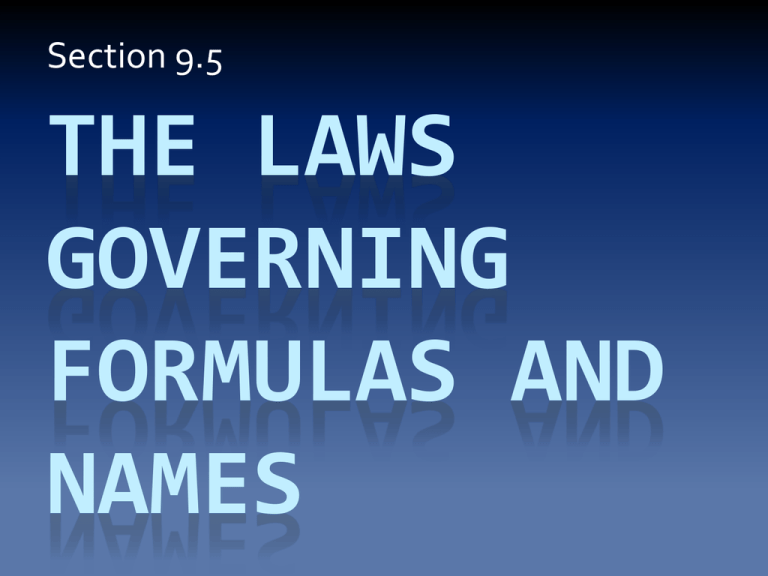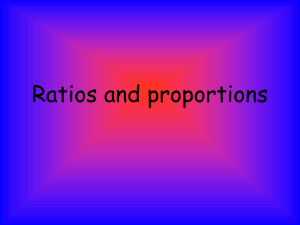The laws governing formulas and names
advertisement

Section 9.5 THE LAWS GOVERNING FORMULAS AND NAMES Scientific Laws • A scientific law is a statement of a relationship that is invariable so far as it is known. • The law of definite proportions and the law of multiple proportions (which we are about to learn) are invariable statements governing the formation of compounds. Historical link • Remember that originally scientists did not know about atoms. We cannot see them. • However, scientists were able to measure masses. • In the early 1800s, many scientists were studying chemical reactions by carefully measuring the masses of reactants and products. Historical Link • The French scientist Joseph Proust demonstrated that samples of copper carbonate always contain 5.3 parts by mass of copper to 4 parts of oxygen and 1 part of carbon. • The principle embodied in this discovery became known as Proust’s Law and later as the law of definite proportions. Law of Definite Proportions • In samples of any one chemical compound, the masses of the elements are always in the same proportions. (Because atoms combine in simple whole-number ratios, their proportions by mass must always be the same.) • Example: Use the models to determine the formulas for the two compounds: Law of Definite Proportions • In what other ways can you tell from the pictures that the two compounds are different? • When water and hydrogen peroxide are broken down into their constituent elements (hydrogen and oxygen) the mass ratios are different: • Water has 1 gram H for every 8 grams of O • Peroxide has 1 gram H for every 16 grams O Historical Link • Proust’s experiments inspired John Dalton to think in terms of atoms. • With atoms in mind, John Dalton designed experiments that soon led to the law of multiple proportions, as well as to Dalton’s atomic theory. • The law of multiple proportions can be described in different ways. Law of Multiple Proportions • In your textbook: Whenever the same two elements form more than one compound, the different masses of one element that combine with the same mass of the other element are in the ratio of small whole numbers. • My preference: When two elements form two different compounds, the mass ratio of the elements in one compound is related to the mass ratio in the other compound by a small whole number. Realplayer\Multiple Proportions.flv Example: • Both of these compounds contain 1 part sulfur (32.06 g). • Sulfur dioxide has 32.00 g of oxygen combining with it, while sulfur trioxide has 48.00 g of oxygen combining with it. • The mass ratio of oxygen in these two compounds is 32 g in SO2 to 48 g in SO3. Note that this ratio (32:48) simplifies to the small whole number ratio 2:3. Naming Compounds Flowchart SiO2 HBr MnCl3 Li3PO3 Ba(OH)2 Writing Formulas Flowchart Hydrogen cyanide Potassium chromate Sulfur tetrafluoride Copper(I) chloride Is that everything? • The binary molecular compounds constitute only a small fraction of molecular compounds. • An enormous number of compounds containing principally carbon, hydrogen, oxygen, nitrogen and sulfur are classified as organic chemicals. • A different, more complex but precise system of naming makes it possible for large and complex molecules to be precisely identified. This would be covered in an organic chemistry class. Anything else? • Some chemicals can exist in a dried out form (called “anhydrous”) as well as in a form where they combine with water molecules (called a “hydrate”). • Copper(II) sulfate is one example. It is white in its anhydrous form (CuSO4), but turns blue when it is hydrated (it combines with 5 water molecules to form the hydrate, 𝐶𝑢𝑆𝑂4 ∙ 5𝐻2 𝑂). References http://reich-chemistry.wikispaces.com/file/view/200pxJoseph_Louis_Proust.jpg/174499761/200px-Joseph_Louis_Proust.jpg http://www.basicfamouspeople.com/pictures/3214.jpg http://www.youtube.com/watch?v=3dWdMqZ2UOU http://www.t3portal.org/T3_Portal_v1/!SSL!/WebHelp/enju_wang/Wange_powerp oint_ppt1_16_01_rot.jpg http://img1.photographersdirect.com/img/13429/ps1104605.jpg






